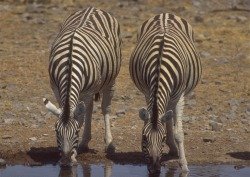ウマ科
| ウマ科 | |||||||||||||||||||||||||||
|---|---|---|---|---|---|---|---|---|---|---|---|---|---|---|---|---|---|---|---|---|---|---|---|---|---|---|---|
 | |||||||||||||||||||||||||||
| 分類 | |||||||||||||||||||||||||||
| |||||||||||||||||||||||||||
| 学名 | |||||||||||||||||||||||||||
| Equidae Gray, 1821[1] | |||||||||||||||||||||||||||
| 和名 | |||||||||||||||||||||||||||
| ウマ科 | |||||||||||||||||||||||||||
| 亜科・族・属 | |||||||||||||||||||||||||||
ウマ科(ウマか、Equidae)は、哺乳綱奇蹄目に属する1科。ウマの仲間を含む。
現生のものとしては、ウマのほかに、ロバ、シマウマ、ノロバなどの仲間を含む。これらはすべてウマ属 Equus に分類される。
形態
[編集]家畜のウマを除いた最大種はグレビーシマウマ。家畜のウマを除いた最小種はアフリカノロバ。
第3指が発達し残りの指は退化しているため、現生種では蹄の数は1つのみである。
現生種を中心とした分類
[編集]- ウマ属 genus Equus
- ウマ亜属 subgenus Equus
- ノウマ Equus ferus, Wild Horse
- †ターパン Equus ferus ferus, Tarpan
- モウコノウマ(プシバルスキーウマ、プルツェワルスキーウマ) Equus ferus przewalskii, Przewalski's Horse
- ウマ Equus ferus caballus, Domestic Horse
- †Equus scotti
- ノウマ Equus ferus, Wild Horse
- ロバ亜属 subgenus Asinus
- アフリカノロバ Equus africanus, African Wild Ass
- アジアノロバ Equus hemionus, Asian wild ass
- モウコノロバ(ジゲタイ) Equus hemionus hemionus
- インドノロバ Equus hemionus khur
- クーラン Equus hemionus kulan
- ゴビノロバ Equus hemionus luteus
- オナガー(ペルシャノロバ) Equus hemionus onager
- †Equus hemionus hemippus
- キャン(チベットロバ、チベットノロバ)Equus kiang, Kiang
- シマウマ亜属 subgenus Hippotigris
- グレビーシマウマ(グレービーシマウマ) Equus grevyi, Grevy's zebra
- サバンナシマウマ Plains Zebra
- †クアッガ (クァッガ、クアッハ) Equus quagga quagga, Quagga
- バーチェルサバンナシマウマ Equus quagga burchellii, Burchell's Zebra
- グラントシマウマ Equus quagga boehmi, Grant's Zebra
- セロウスシマウマ Equus quagga borensis, Selous' zebra
- チャプマンシマウマ(チャップマンシマウマ) Equus quagga chapmani, Chapman's Zebra
- クロウシェイズシマウマ Equus quagga crawshayi, Crawshay's Zebra
- ヤマシマウマ Equus zebra, Mountain Zebra
- ウマ亜属 subgenus Equus
※†は絶滅を示す。
種間雑種
[編集]以下のような種間雑種が存在する。
- ラバ (Mule): オスのロバ × メスのウマ
- ケッテイ(駃騠) (Hinny): オスのウマ × メスのロバ
- ゾース(黄金シマウマ) (Zorse): オスのシマウマ × メスのウマ
- ジードンク (Zeedonk) またはゾンキー (Zonkey): ロバ × シマウマ
- ゾニー (Zony): オスのシマウマ × メスのポニー
シマウマと他種との種間雑種は、すべてゼブロイド (zebroid) と呼ばれる。
化石種を含めた分類
[編集]→「ウマの進化」も参照
- Order Perissodactyla 奇蹄目
- Family Equidae ウマ科
- Subfamily †Eohippinae
- Subfamily †Propalaeotheriinae
- Genus †Orohippus オロヒップス
- Genus †Pliolophus
- Genus †Protorohippus
- Genus †Sifrhippus
- Genus †Xenicohippus[3]
- Genus †Eurohippus
- Genus †Propalaeotherium?[4]
- Subfamily †Anchitheriinae
- Genus †Anchitherium
- Genus †Archaeohippus
- Genus †Desmatippus
- Genus †Hypohippus
- Genus †Kalobatippus カロバティップス
- Genus †Megahippus
- Genus †Mesohippus メソヒップス
- Genus †Miohippus ミオヒップス
- Genus †Parahippus パラヒップス
- Genus †Sinohippus
- Subfamily Equinae
- Genus †Merychippus メリキップス
- Genus †Scaphohippus
- Genus †Acritohippus
- Tribe †Hipparionini
- Genus †Eurygnathohippus
- Genus †Hipparion ヒッパリオン
- Genus †Hippotherium
- Genus †Nannippus
- Genus †Neohipparion
- Genus †Proboscidipparion
- Genus †Pseudhipparion
- Tribe Equini
- Genus †Haringtonhippus[5]
- Genus †Heteropliohippus[6]
- Genus †Parapliohippus[6]
- Subtribe Protohippina
- Genus †Calippus
- Genus †Protohippus
- Subtribe Equina
- Genus †Astrohippus
- Genus †Dinohippus ディノヒップス
- Genus Equus ウマ属
- Equus ferus ノウマ
- †Equus algericus[7]
- †Equus alaskae
- †Equus lambei
- †Equus niobrarensis
- †Equus scotti
- †Equus conversidens
- †Equus semiplicatus
- Subgenus †Amerhippus (おそらくE. ferusとシノニム)[8]
- Subgenus Asinus
- Subgenus Hippotigris シマウマ
- Subgenus †Parastylidequus
- †Subgenus Sussemionus[9]
- incertae sedis
- †Equus (A.) excelsus
- Genus †Hippidion
- Genus †Onohippidium
- Genus †Pliohippus プリオヒップス
- Family Equidae ウマ科
関連項目
[編集]参考文献
[編集]- Duncan, P. (ed.). 1992. Zebras, Asses, and Horses: an Action Plan for the Conservation of Wild Equids. IUCN/SSC Equid Specialist Group. IUCN, Gland, Switzerland.
- Equid Specialist Group 1996. Equus ferus. In: IUCN 2004. 2004 IUCN Red List of Threatened Species. <www.iucnredlist.org>. Downloaded on 21 January 2006.
- Equid Specialist Group 1996. Equus ferus ssp. przewalskii. In: IUCN 2004. 2004 IUCN Red List of Threatened Species. <www.iucnredlist.org>. Downloaded on 21 January 2006.
- Groves, C.P. & Bell, H.B. 2004. New investigations on the taxonomy of the zebras genus Equus, subgenus Hippotigris. Mammalian Biology. 69: 182-196.
- Higuchi et al. 1987. Mitochondrial DNA of the Extinct Quagga: Relatedness and Extent of Postmortem Change. Journal of Molecular Evolution 25:283-287.
- International Commission on Zoological Nomenclature. 2003. Opinion 2027 (Case 3010). Usage of 17 specific names based on wild species which are pre-dated by or contemporary with those based on domestic animals (Lepidoptera, Osteichthyes, Mammalia): conserved. Bull.Zool.Nomencl., 60:81-84.
- Moehlman, P.D. 2002. Equids. Zebras, Assess and Horses. Status Survey and Conservation Action Plan. IUCN/SSC Equid Specialist Group. IUCN, Gland, Switzerland. [1]
出典
[編集]- ^ “Fossilworks - Equidae”. Fossilworks. 2015年11月20日閲覧。
- ^ “Fossilworks - Equus”. Fossilworks. 2015年11月20日閲覧。
- ^ a b Froehlich, D.J. (February 2002). “Quo vadis eohippus? The systematics and taxonomy of the early Eocene equids (Perissodactyla)”. Zoological Journal of the Linnean Society 134 (2): 141–256. doi:10.1046/j.1096-3642.2002.00005.x.
- ^ Remy, Jean A.; Krasovec, Gabriel; Marandat, Bernard (2016). “A new species of Propalaeotherium (Palaeotheriidae, Perissodactyla, Mammalia) from the Middle Eocene locality of Aumelas (Hérault, France)”. Palaeovertebrata 40 (2): e1. doi:10.18563/pv.40.2.e1.
- ^ Hay, Oliver P. (1915). "Contributions to the Knowledge of the Mammals of the Pleistocene of North America". Proceedings of the United States National Museum. 48 (2086): 535–549. doi:10.5479/si.00963801.48-2086.515
- ^ a b Bravo-Cuevas, V.M.; Ferrusquía-Villafranca, I. (2010). “The oldest record of Equini (Mammalia: Equidae) from Mexico”. Revista Mexicana de Ciencias Geológicas 27 (3): 593–603 14 August 2020閲覧。.
- ^ Aouraghe, Hassan (1999). “Les équidés du Pléstocène supérior de la grotte Zouhrah à El Harhoura, Maroc” (フランス語). Quaternaire 10: 283–292. doi:10.3406/quate.1999.1649.
- ^ Orlando, L. (2008). “Ancient DNA Clarifies the Evolutionary History of American Late Pleistocene Equids”. Journal of Molecular Evolution 66 (5): 533–538. Bibcode: 2008JMolE..66..533O. doi:10.1007/s00239-008-9100-x. PMID 18398561.
- ^ Eisenmann, Vera (March 2010). “Sussemionus, a new subgenus of Equus (Perissodactyla, Mammalia)”. Comptes Rendus Biologies 333 (3): 235–240. doi:10.1016/j.crvi.2009.12.013. PMID 20338542.
- ^ Eisenmann, Vera; Vasilijiev, Sergej (September 2011). “Unexpected finding of a new Equus species (Mammalia, Perissodactyla) belonging to a supposedly extinct subgenus in late Pleistocene deposits of Khakassia (Southwestern Siberia)”. Geodiversitas 33 (3): 519–530. doi:10.5252/g2011n3a5.
- ^ “Fossilworks: Equus fraternus”. fossilworks.org. 17 December 2021閲覧。


 French
French Deutsch
Deutsch